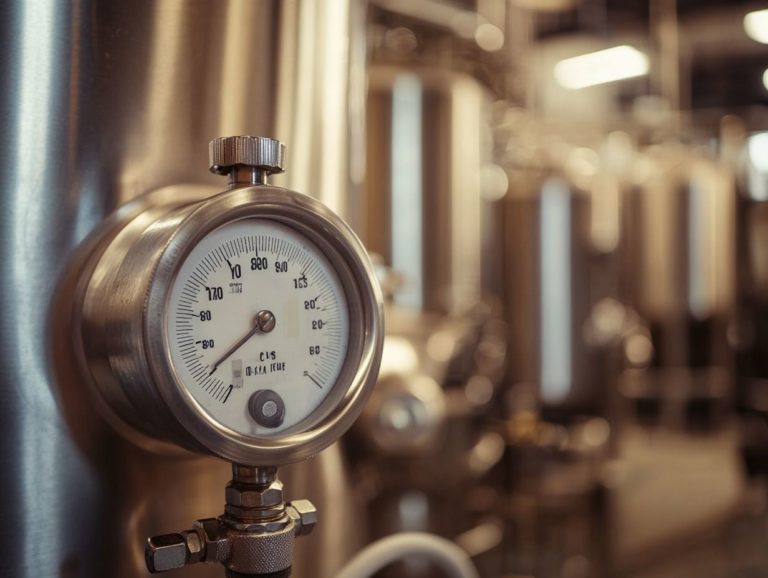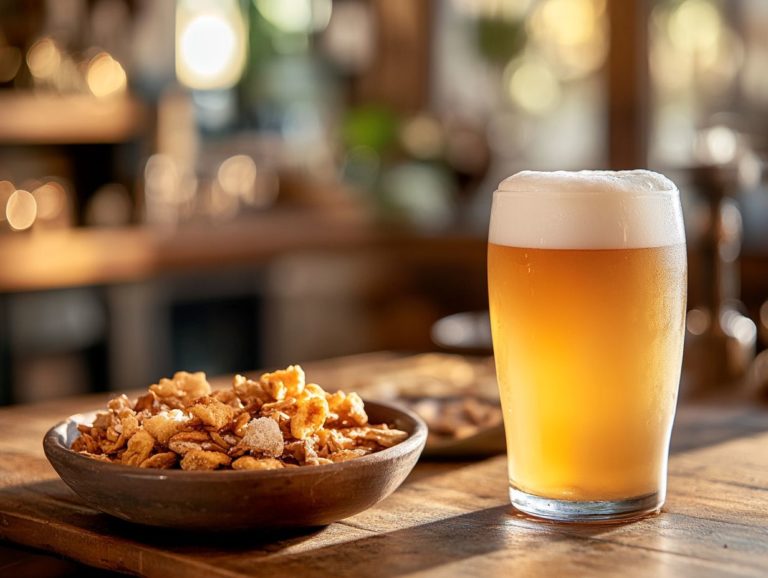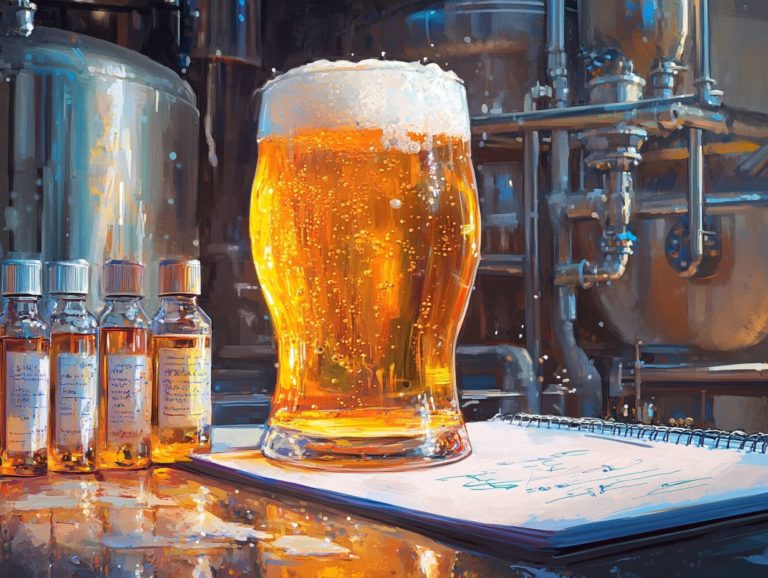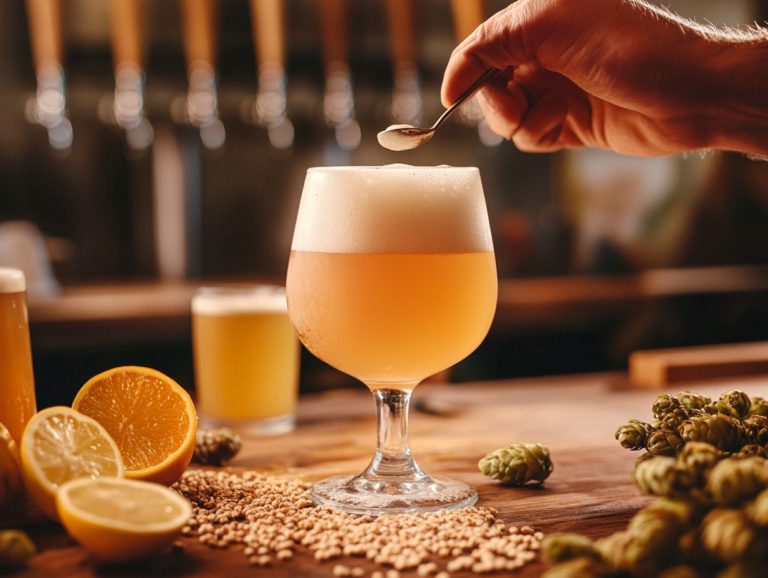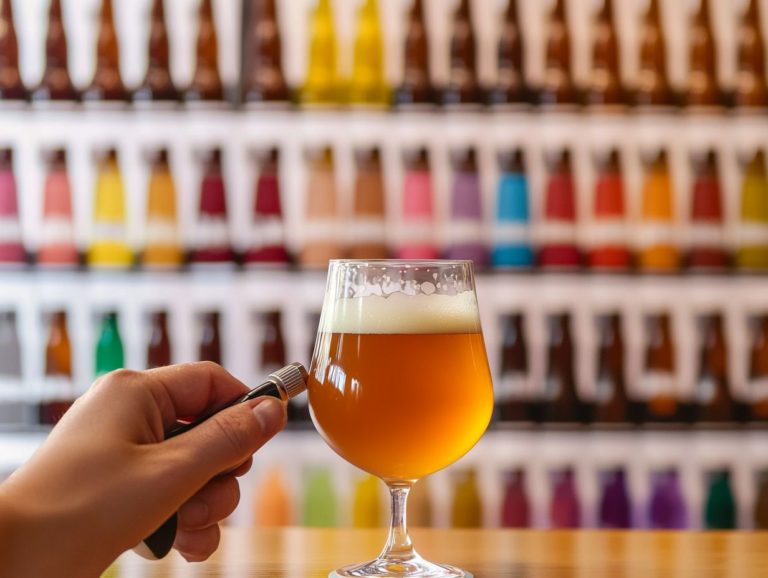5 Home Brewing Problems and Their Solutions
Home brewing is a remarkably rewarding hobby, yet it certainly comes with its fair share of challenges. From the nuisance of contamination to the frustration of off-flavors, even the most seasoned brewers may find themselves grappling with a variety of issues that can detract from their craft.
In this article, you ll discover five common home brewing problems such as carbonation issues and cloudy beer and practical solutions designed to elevate your brewing experience. Whether you’re just starting out or you ve been honing your skills for years, these tips will empower you to sidestep pitfalls and craft beer that you can genuinely take pride in.
Contents
- Key Takeaways:
- 1. Contamination
- 2. Off-Flavors
- 3. Carbonation Issues
- 4. Low Alcohol Content
- 5. Cloudy Beer
- How to Avoid Common Home Brewing Problems
- What Are Some Common Mistakes to Avoid?
- How Can One Troubleshoot and Fix Home Brewing Problems?
- What Are Some Tips for Improving the Quality of Home Brewed Beer?
- Is Home Brewing Worth the Time and Effort?
- Frequently Asked Questions
- 1. What are the most common home brewing problems and their solutions?
- 2. How can I prevent contamination in my home-brewed beer?
- 3. Why does my home-brewed beer have off-flavors?
- 4. How can I ensure consistent carbonation in my home-brewed beer?
- 5. What should I do if my home-brewed beer has a low alcohol content?
- 6. How can I achieve clarity in my home-brewed beer?
Key Takeaways:

- Contamination is a common issue in home brewing, but can be prevented by properly sanitizing equipment and keeping a clean brewing environment.
- Off-flavors, such as a metallic taste, can be fixed by using high-quality ingredients and controlling fermentation temperature.
- Carbonation issues can be solved by carefully measuring priming sugar and allowing for proper fermentation time.
1. Contamination
Contamination in home brewing can lead to disastrous outcomes, affecting everything from fermentation to carbonation. It s crucial for you to grasp the sources of these unwanted bacteria or yeast and the methods for preventing them to secure a successful batch of beer.
Common contaminants, such as wild yeast and bacteria, can introduce off-flavors that disrupt the delicate balance of the brewing process. To combat these challenges, you must adhere to effective sanitation practices with unwavering diligence. Start by thoroughly cleaning all your brewing equipment before and after each use. This includes kettles, fermenters, and even your utensils.
Managing the balance of minerals and pH in your brewing water is equally important; ensuring the optimal levels will create a healthy brewing environment. You should incorporate proper brewing techniques, like boiling for the right duration, to eliminate harmful organisms and uphold the overall quality and integrity of your beer.
2. Off-Flavors
Off-flavors in your home brewed beer can stem from a variety of factors during the brewing process. Elements like incorrect fermentation temperature and poor ingredient selection can significantly affect your final product, leading to undesirable tastes that detract from the intended beer styles.
Understanding these off-flavors is essential for any home brewer. Take diacetyl, for instance; it’s often described as having a buttery flavor and usually arises from yeast stress during fermentation. By maintaining adequate fermentation temperature control and selecting the right yeast, you can easily mitigate this issue.
Then there’s acetaldehyde, which gives off a green apple taste and may occur due to premature fermentation or oxidation. Keeping a vigilant eye on your fermentation schedules and minimizing oxygen exposure at different stages will help you reduce these pesky attributes.
By crafting a well-balanced recipe and making thoughtful brewing adjustments, not only can you prevent these flaws, but you can also enhance the overall flavor profile of your brew. This will ensure that you produce a fine beer, free from harsh or off-putting notes.
3. Carbonation Issues
Carbonation issues are a common challenge that you may encounter as a home brewer. These problems often stem from incorrect fermentation control or improper kegging techniques, which can lead to either under-carbonated or over-carbonated beer, ultimately impacting the mouthfeel and overall enjoyment of your brew.
Understanding how to achieve the right carbonation levels is essential for anyone striving to perfect their craft. You have two primary methods at your disposal: natural carbonation through fermentation, where yeast produces carbon dioxide during the conditioning phase, and forced carbonation, which involves injecting CO2 into the beer while it s in a keg.
As a brewer, it s vital to closely monitor temperatures and pressure during both methods. These fine-tuning practices can help you avoid issues such as over-foaming or flatness. When carbonation problems do arise, you can typically resolve them by adjusting the keg’s pressure or ensuring that fermentation is complete before bottling.
In the end, precise measurements and regular monitoring can make all the difference between a good batch of beer and a truly exceptional one.
Let’s dive into five common brewing problems. Follow these tips and start brewing the beer of your dreams today!
4. Low Alcohol Content

Experiencing low alcohol content in your homebrewed beer can be quite the letdown. This often stems from inaccurate original gravity measurements, improper brewing ratios, or fermentation hiccups that prevent sugars from converting effectively into alcohol during the brewing process.
To elevate your brewing game, it s essential to understand how to accurately measure both original gravity and final gravity with a hydrometer. Your original gravity reading serves as a key indicator of the potential alcohol content, while the final gravity reveals the amount of residual sugar left after fermentation.
A simpler way to achieve your desired alcohol levels is to adjust the ratios of malt extract and sugars in your recipe. By mastering these crucial measurements and adjustments, you can create a more consistent and satisfying brew, ultimately enriching your overall brewing experience.
5. Cloudy Beer
Cloudy beer can be quite the vexing dilemma for you as a homebrewer. It often results from insufficient fermentation temperature control, subpar yeast performance, or even the presence of brewing salts that compromise the clarity and overall presentation of your brew.
Achieving a crystal-clear beer is crucial, not just for its aesthetic allure but also for the perception of quality it imparts. One of the main offenders in producing cloudiness is yeast; if not managed properly, it can leave behind an unwelcome haze.
To ensure your yeast flocculates effectively towards the end of fermentation, controlling the temperature carefully is important. You might also consider incorporating clarifying agents like gelatin, isinglass, or polyclar to help settle out any unwanted particulates.
By grasping these factors and addressing them throughout the brewing process, you can significantly elevate both the clarity and quality of your final product.
How to Avoid Common Home Brewing Problems
Avoiding common home brewing problems requires your careful attention to detail throughout the entire brewing process. This means:
- Selecting high-quality ingredients.
- Maintaining proper fermentation control.
- Utilizing the right brewing equipment and methods.
To truly elevate your home brewing experience, you must prioritize sanitation. Even the tiniest, unseen contaminants can significantly impact flavor and quality. Choosing the finest hops, grains, and yeasts is imperative, as their unique qualities can greatly influence your final product.
Precise measurements are equally critical. Even minor deviations can lead to less-than-desirable outcomes. If you encounter challenges, remember to regularly check fermentation temperatures and make adjustments as needed this can save your brew from turning sour.
Experimenting with small batches can provide invaluable lessons. This helps you develop a deeper understanding of individual ingredients while mastering techniques that refine your brewing process.
What Are the Key Factors to Consider When Brewing at Home?
When you embark on the journey of brewing at home, several key factors demand your attention to guarantee a successful batch of beer. You’ll want to consider yeast performance, fermentation temperature, water chemistry, and the selection of brewing equipment that complements the specific beer style you re aiming to create.
The health of your yeast is paramount; it directly impacts how efficiently sugar transforms into alcohol and ultimately influences the flavor profile and overall quality of your brew.
Optimal fermentation temperatures are equally critical. Straying too high or too low risks introducing off-flavors or causing stalled fermentation that could compromise your entire batch.
Understanding water chemistry is also essential. The mineral content in your water can either enhance or detract from the desired taste and aroma of your beer.
Choosing the right equipment be it fermenters, kettles, or filtration systems is crucial. Tailoring your setup to accommodate various brewing techniques and styles ensures that your process yields the finest possible outcome.
What Are Some Common Mistakes to Avoid?
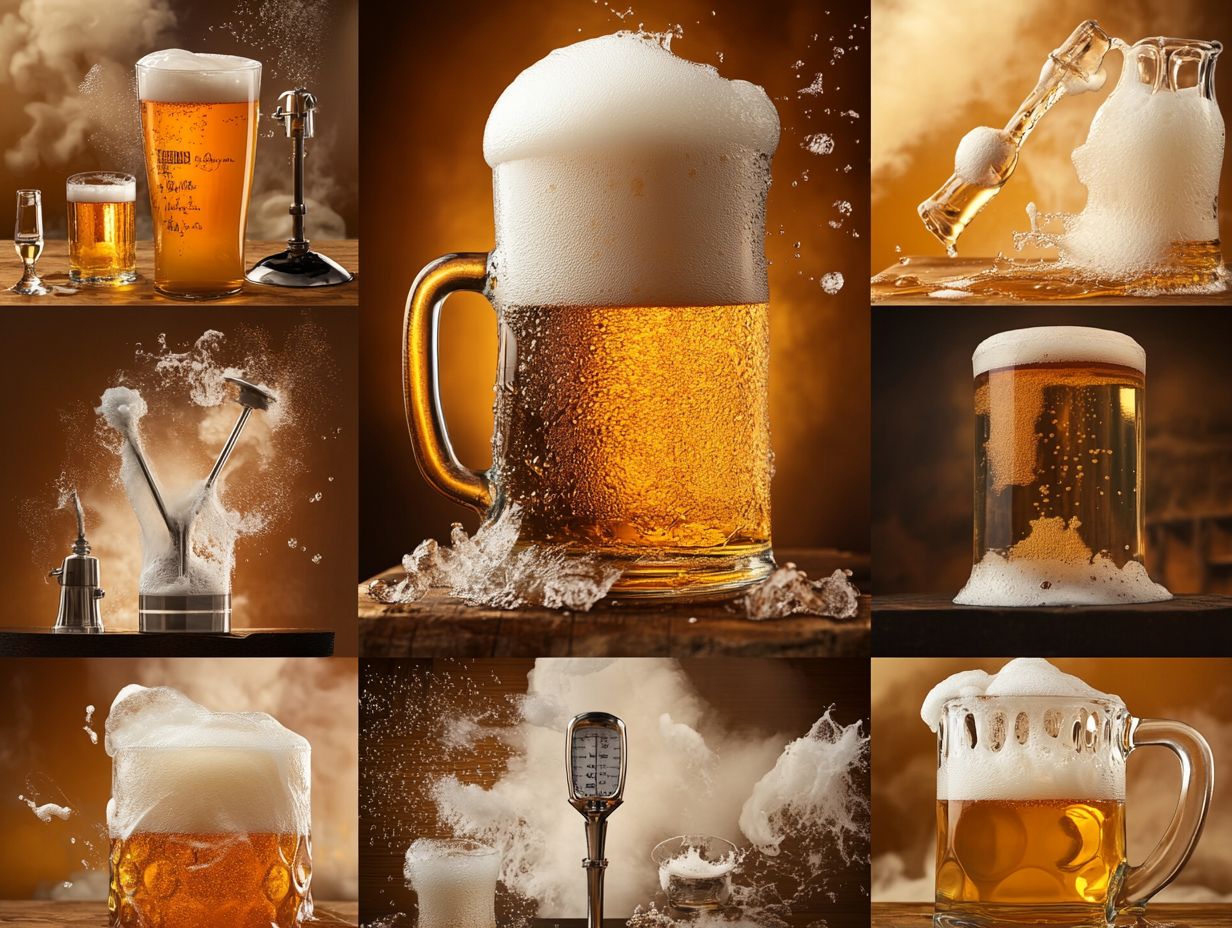
As a homebrewer, you may find yourself stumbling upon common mistakes that can truly impede your brewing journey. These missteps might include failing to control fermentation conditions, miscalculating brewing ratios, or neglecting proper sanitation practices. All of these can result in off-flavors or other undesirable outcomes in your beer.
Fortunately, these pitfalls can be easily avoided with a bit of vigilance and a solid grasp of brewing fundamentals. For instance, maintaining a stable fermentation temperature is crucial. Fluctuations can disrupt yeast activity, affect the original gravity, and ultimately alter the flavor profile of your brew.
Accurate measurements of ingredients like malt and hops are essential for achieving the desired balance and character in your final product. Miscalculating these brewing ratios can lead to brews that are overly bitter or sweet, straying far from your intended recipe.
Moreover, proper sanitation is absolutely paramount. Any contaminants introduced during the brewing process can spoil your beer or impart unwelcome flavors. By honing in on these critical aspects, you can take your brewing journey to the next level!
How Can One Troubleshoot and Fix Home Brewing Problems?
Effective troubleshooting in home brewing is essential for addressing any problems that arise during the brewing process. By diagnosing issues related to fermentation, carbonation levels, or flavor, you can implement the necessary adjustments to salvage your beer.
As you systematically tackle each concern, you ll begin to notice the subtle nuances in your techniques everything from inadequate yeast activity to unexpected off-flavors. Identifying specific signs, such as stuck fermentation or overly sweet beers, will prompt you to evaluate key factors like fermentation control, ingredient quality, and sanitation practices.
Each symptom you encounter may have multiple potential causes. For instance, an overly vigorous fermentation could lead to excessive carbonation, while a lackluster hop profile might suggest that your ingredients are past their prime. By adopting a methodical approach, you not only pinpoint these issues effectively but also empower yourself to test hypotheses and refine your craft, ensuring that every batch reaches its utmost potential. Monitoring hydrometer readings and wort gravity helps you identify problems early.
What Are Some Tips for Improving the Quality of Home Brewed Beer?
Improving the quality of your home-brewed beer demands a harmonious blend of knowledge, skill, and the right techniques. From refining your recipes and making precise brewing adjustments to mastering water chemistry, each element plays a vital role in enhancing flavor and clarity.
Delving into the world of ingredients is essential. When you select high-quality malt, hops, and yeast, you set the stage for a remarkable final product. Exploring various grain bills and hop varieties will unlock unique flavor profiles that distinguish your brew from the rest. Proper grain crush and wort extraction techniques will further ensure optimal brewing results.
Engaging in consistent experimentation with different brewing methods whether it s tweaking boil times, adjusting fermentation temperatures, or even varying the types of water used opens up a realm of possibilities tailored to your palate.
- Encourage fellow brewers to document their processes and outcomes.
- Create a vibrant community of learning.
- Pave the way for continuous improvement in the art of craft brewing.
At the end of each section, remember to recap the main points to reinforce the key takeaways for your brewing journey.
Share your own tips and experiences in the comments below, fostering a sense of community and continuous learning!
Ready to take your brewing skills to the next level? Apply what you ve learned today and share your brewing stories on social media!
Is Home Brewing Worth the Time and Effort?
Many aspiring brewers find themselves pondering whether home brewing is truly worth the time and effort. With the complexities of the brewing process, the multitude of beer styles waiting to be explored, and the investment in brewing equipment necessary to produce high-quality beer, it can be a daunting prospect.
However, for those who embark on this creative journey, the rewards can be immensely gratifying. Crafting unique beers gives you the opportunity to experiment with flavors and techniques, offering a sense of accomplishment that few hobbies can rival.
This journey may involve exploring various beer recipes and tweaking the mash temperature (the temperature at which grains are soaked to extract sugars) to achieve the desired flavor profile.
Of course, brewing comes with its own set of challenges, especially the steep learning curve tied to mastering fermentation and selecting the right ingredients. Luckily, you re not alone! The enthusiastic Homebrew community is eager to help, providing a wealth of resources and camaraderie to help you navigate these obstacles with confidence.
In many ways, home brewing mirrors the coffee culture; enthusiasts relish the chance to experiment with beans and brewing methods, sharing their passion and expertise while cultivating a strong sense of belonging in both pursuits. Both activities involve a deep understanding of various brewing processes and techniques, whether it s beer or coffee brewing.
Frequently Asked Questions
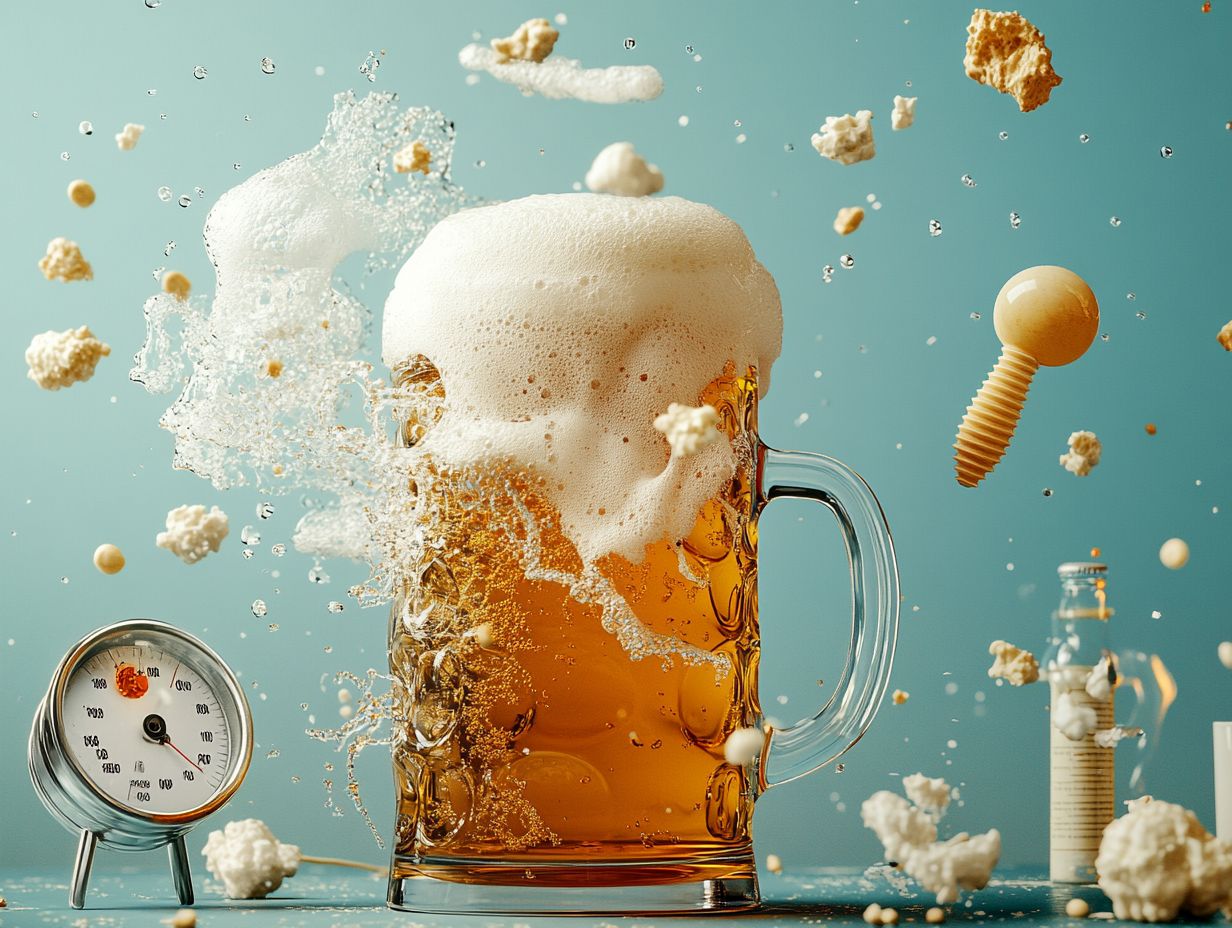
1. What are the most common home brewing problems and their solutions?
Some of the most common problems encountered by home brewers include contamination, off-flavors, inconsistent carbonation, low alcohol content, and lack of clarity in the final product. These issues can be resolved by practicing proper sanitation, controlling fermentation temperature, using high-quality ingredients, and accurately following a recipe formulation.
2. How can I prevent contamination in my home-brewed beer?
The best way to prevent contamination is to thoroughly clean and sanitize all brewing equipment before use. Make sure to use a food-grade sanitizer and follow the recommended contact time. Also, avoid introducing foreign objects and unnecessary air exposure during the brewing process. Employing a kegging method can help reduce the risk of contamination.
3. Why does my home-brewed beer have off-flavors?
Off-flavors in beer can be caused by several factors, such as using old or expired ingredients, poor sanitation practices, or improper storage. To prevent off-flavors, ensure you use fresh ingredients, properly sanitize equipment, and store the finished beer in a cool, dark place. Monitoring wort gravity and final gravity can help identify potential issues early.
4. How can I ensure consistent carbonation in my home-brewed beer?
Inconsistent carbonation is often due to improper priming or bottling. It’s important to measure and add the correct amount of priming sugar to the beer before bottling. Also, ensure you properly seal and store the bottles at the recommended temperature for carbonation. Checking hydrometer readings can also ensure that the carbonation levels are consistent.
5. What should I do if my home-brewed beer has a low alcohol content?
A low alcohol content in beer can result from using low-quality or old ingredients, not using enough malt extract, or not allowing enough time for fermentation. To increase the alcohol content, use fresh and high-quality ingredients, measure and add enough malt extract, and give the beer enough time to ferment. Including a hydrometer in your brewing supplies can help you monitor alcohol levels accurately.
6. How can I achieve clarity in my home-brewed beer?
Achieving clarity in beer can be a challenge for home brewers, but it can be accomplished by using a clarifying agent such as Irish moss or gelatin, cold crashing the beer, and properly racking the beer from one vessel to another to minimize sediment. Additionally, make sure to use high-quality ingredients and practice proper sanitation to prevent any cloudiness.
Ready to start your home brewing journey? Dive in and enjoy the process of creating your unique beers today!

